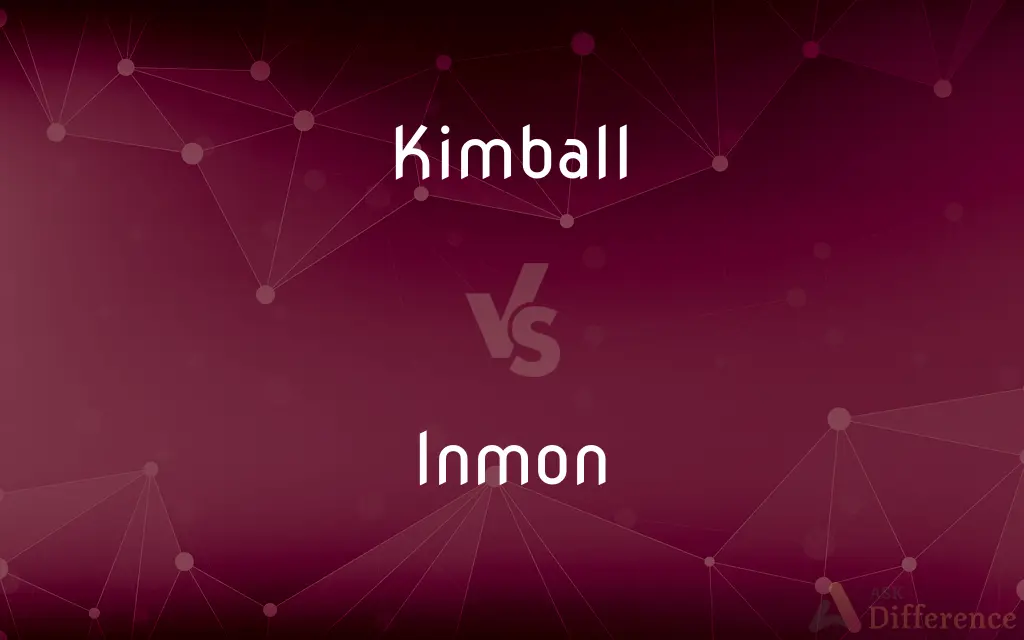Kimball vs. Inmon — What's the Difference?
By Tayyaba Rehman — Published on January 1, 2024
Kimball and Inmon are two methodologies for designing data warehouse architectures. Kimball focuses on a bottom-up approach with dimensional modeling, while Inmon advocates a top-down approach with normalized modeling.

Difference Between Kimball and Inmon
Table of Contents
ADVERTISEMENT
Key Differences
Kimball approach, developed by Ralph Kimball, emphasizes the dimensional modeling technique. It advocates for starting data warehouse design with business processes and building data marts for each process, which are then integrated. The Inmon approach, developed by Bill Inmon, is based on building a centralized, normalized data warehouse before any dimensional data marts, focusing on creating a single, consistent data model.
In the Kimball methodology, the focus is on delivering practical, usable data marts quickly that directly address business needs. This approach is often faster to implement and provides immediate value to business users. In contrast, the Inmon approach prioritizes a comprehensive data warehouse model that ensures data consistency and is more scalable in the long term but can be slower and more complex to implement.
Kimball's dimensional models are easier for business users to understand and navigate, as they directly align with business processes. However, Inmon's normalized model, while more complex, avoids data redundancy and maintains data integrity across the organization.
For integration, the Kimball approach integrates data at the data mart level, allowing for flexibility and quicker deployment. Inmon's approach centralizes integration at the data warehouse level, which requires more upfront work but leads to a more unified data environment.
Kimball is often preferred for smaller to medium-sized projects or those requiring quick, tangible results. Inmon's methodology, being more comprehensive and systematic, is suited for large-scale enterprises where long-term data consistency and scalability are crucial.
ADVERTISEMENT
Comparison Chart
Approach
Bottom-up, dimensional modeling
Top-down, normalized modeling
Focus
Business processes and data marts
Centralized data warehouse
Implementation Speed
Faster, practical implementation
Slower, methodical implementation
Data Model
Easier for end-users, aligned with business needs
Complex, centralized, avoids redundancy
Best Suited For
Quick results, small to medium-sized projects
Large-scale, enterprise environments
Compare with Definitions
Kimball
Focuses on dimensional modeling.
The Kimball approach streamlined our sales data into an easily understandable format.
Inmon
Ensures enterprise-wide data consistency.
Inmon's approach was key in maintaining data integrity for our large enterprise.
Kimball
Emphasizes quick, practical value.
Kimball's methodology enabled us to see business benefits in a short time.
Inmon
Uses a top-down, normalized approach.
Following Inmon, we developed a consistent data model across the organization.
Kimball
Aligns data architecture with business processes.
Our marketing analytics were greatly improved by adopting the Kimball approach.
Inmon
Based on building a centralized data warehouse.
Inmon’s methodology helped us create a unified data warehouse for all our data.
Kimball
Integrates data at the data mart level.
Under Kimball, different data marts were integrated to provide a comprehensive view.
Inmon
Focuses on long-term scalability.
Adopting Inmon’s methodology prepared our data architecture for future growth.
Kimball
Advocates a bottom-up approach.
Using Kimball, we quickly developed individual data marts for each department.
Inmon
Integrates data at the warehouse level.
With Inmon, we centralized data integration to ensure consistency.
Common Curiosities
What is the Inmon methodology?
A comprehensive data warehouse approach based on normalized modeling from the top down.
What is the Kimball methodology?
A data warehousing approach focusing on dimensional modeling and bottom-up design.
Can Kimball and Inmon be combined?
Yes, some organizations blend elements of both for a more tailored solution.
Does Inmon focus on data quality?
Yes, Inmon’s approach inherently focuses on data quality and integrity.
Which is quicker to implement, Kimball or Inmon?
Kimball is generally quicker due to its focus on immediate, practical results.
Which approach is more user-friendly for business analysts?
Kimball, as its dimensional model is often more aligned with business processes.
How do Kimball and Inmon handle data redundancy?
Kimball may have some redundancy due to its independent data marts, while Inmon minimizes redundancy through a centralized model.
Is Inmon better for large organizations?
Yes, due to its emphasis on long-term data consistency and scalability.
Is Kimball's approach less scalable than Inmon's?
It can be, particularly in very large or complex data environments.
How does Inmon's approach affect data integration?
It centralizes integration, which can be complex but ensures consistency.
Should start-ups use Kimball or Inmon?
Start-ups might prefer Kimball for its quicker implementation and lower initial complexity.
Do I need a big team to implement Inmon’s methodology?
Generally, yes, as it is more complex and resource-intensive.
Is Inmon's approach more complex to understand?
Yes, due to its comprehensive and normalized nature.
Which methodology is faster for reporting and analysis?
Kimball, as it provides quick access to business-focused data marts.
Can small businesses effectively use Kimball's approach?
Yes, it's often suitable for smaller organizations due to its practicality and speed.
Share Your Discovery

Previous Comparison
Debit Balance vs. Credit Balance
Next Comparison
SOAP vs. WSDLAuthor Spotlight
Written by
Tayyaba RehmanTayyaba Rehman is a distinguished writer, currently serving as a primary contributor to askdifference.com. As a researcher in semantics and etymology, Tayyaba's passion for the complexity of languages and their distinctions has found a perfect home on the platform. Tayyaba delves into the intricacies of language, distinguishing between commonly confused words and phrases, thereby providing clarity for readers worldwide.














































